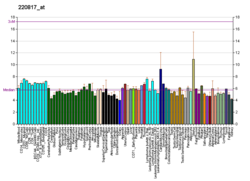호모사피엔스 종의 단백질 코딩 유전자
TRP 관련 단백질 4 라고도 알려진 짧은 과도 수용체 전위 채널 4 (TrpC4)는 인간에서 TRPC4 유전자 에 의해 인코딩 되는 단백질이다.[5] [6]
함수 TrpC4는 과도 수용체 전위 양이온 채널 의 일원이다. 이 단백질은 Gαi 결합 수용체, Gαq 수용체 , 티로신 키나제스 에 의해 활성화되는 비선택적 칼슘-perme cation 채널을 형성하며, 내피투과성 , 혈관절제 , 신경전달물질 방출, 세포 증식 등의 다과정에 역할을 한다.[7]
조직 분포 비선택적 양이온 채널 TrpC4는 뇌의 코르티코 [8] 또한 TRPC4 mRNA는 복측 티그먼트 부위 의 중간뇌 도파민성 뉴런과 실체성 니그라 에 존재한다.[9]
역할 trpc4 유전자의 삭제는 사회탐구 과제에서 사회성을 감소시킨다.이러한 결과는 TRPC4가 여러 가지 다른 장애에서 사회적 불안을 조절하는 역할을 할 수 있음을 시사한다.[10] 그러나 trpc4 유전자의 삭제는 기본적 또는 복잡한 전략적 학습에 영향을 미치지 않았다.[11] trpc4 유전자가 선택된 중뇌 도파민 뉴런 집단에서 발현된다는 점에서 중독과 주의력을 포함한 도파민 관련 과정에 중요한 역할을 할 수 있다는 제안이 나왔다.[9]
임상적 유의성 이 유전자의 단일 뉴클레오티드 다형성증 은 일반화된 간질과 광감성 을 동반할 수 있다.[12]
상호작용 TRPC4는 ITPR1 , [13] [14] TRPC1 , [15] [16] TRPC5 와 상호작용 하는 것으로 나타났다.[16]
참고 항목 참조 ^ a b c GRCh38: 앙상블 릴리스 89: ENSG00000133107 - 앙상블 , 2017년 5월^ a b c GRCm38: 앙상블 릴리스 89: ENSMUSG000027748 - 앙상블 , 2017년 5월^ "Human PubMed Reference:" . National Center for Biotechnology Information, U.S. National Library of Medicine .^ "Mouse PubMed Reference:" . National Center for Biotechnology Information, U.S. National Library of Medicine .^ Zhu X, Jiang M, Peyton M, Boulay G, Hurst R, Stefani E, Birnbaumer L (May 1996). "trp, a novel mammalian gene family essential for agonist-activated capacitative Ca2+ entry" . Cell . 85 (5): 661–71. doi :10.1016/S0092-8674(00)81233-7 PMID 8646775 . ^ Clapham DE, Julius D, Montell C, Schultz G (December 2005). "International Union of Pharmacology. XLIX. Nomenclature and structure-function relationships of transient receptor potential channels". Pharmacol. Rev . 57 (4): 427–50. doi :10.1124/pr.57.4.6 . PMID 16382100 . S2CID 17936350 . ^ "Entrez Gene: transient receptor potential cation channel, subfamily C, member 4" .^ Fowler MA, Sidiropoulou K, Ozkan ED, Phillips CW, Cooper DC (2007). "Corticolimbic expression of TRPC4 and TRPC5 channels in the rodent brain" . PLOS ONE . 2 (6): e573. Bibcode :2007PLoSO...2..573F . doi :10.1371/journal.pone.0000573 PMC 1892805 PMID 17593972 . ^ a b Cooper D, Illig K, Varnell A, Ostertag E, Klipec W (2011). "TRPC4 ion channel protein is selectively expressed in a subpopulation of dopamine neurons in the ventral tegmental area". Nature Precedings . arXiv :1204.0142 doi :10.1038/npre.2011.6577.1 . S2CID 19188350 . ^ Cooper D, Rasmus K, Wang J-G, Varnell A, Ostertag E (2011). "Sociability is decreased following deletion of the trpc4 gene" . Nature Precedings . doi :10.1038/npre.2011.6367.1 ^ Cooper D, Collins M, Drish A, Swenson L, Ostertag E, Klipec W, Nguyen P, Deeney B, Williamson C, Wenzel K, Stumme J (2012). "Deletion of the trpc4 gene and its role in simple and complex strategic learning" . Nature Precedings . doi :10.1038/npre.2012.6929.1 ^ von Spiczak S, Muhle H, Helbig I, de Kovel CG, Hampe J, Gaus V, Koeleman BP, Lindhout D, Schreiber S, Sander T, Stephani U (September 2010). "Association study of TRPC4 as a candidate gene for generalized epilepsy with photosensitivity". Neuromolecular Med . 12 (3): 292–9. doi :10.1007/s12017-010-8122-x . hdl :11858/00-001M-0000-0029-429E-D PMID 20574736 . S2CID 20930490 . ^ Yuan JP, Kiselyov K, Shin DM, Chen J, Shcheynikov N, Kang SH, Dehoff MH, Schwarz MK, Seeburg PH, Muallem S, Worley PF (September 2003). "Homer binds TRPC family channels and is required for gating of TRPC1 by IP3 receptors" . Cell . 114 (6): 777–89. doi :10.1016/S0092-8674(03)00716-5 PMID 14505576 . ^ Mery L, Magnino F, Schmidt K, Krause KH, Dufour JF (January 2001). "Alternative splice variants of hTrp4 differentially interact with the C-terminal portion of the inositol 1,4,5-trisphosphate receptors". FEBS Lett . 487 (3): 377–83. doi :10.1016/S0014-5793(00)02362-0 . PMID 11163362 . S2CID 44945442 . ^ Strübing C, Krapivinsky G, Krapivinsky L, Clapham DE (October 2003). "Formation of novel TRPC channels by complex subunit interactions in embryonic brain" . J. Biol. Chem . 278 (40): 39014–9. doi :10.1074/jbc.M306705200 PMID 12857742 . ^ a b Hofmann T, Schaefer M, Schultz G, Gudermann T (May 2002). "Subunit composition of mammalian transient receptor potential channels in living cells" . Proc. Natl. Acad. Sci. U.S.A . 99 (11): 7461–6. Bibcode :2002PNAS...99.7461H . doi :10.1073/pnas.102596199 PMC 124253 PMID 12032305 . 추가 읽기 Islam, Md. Shahidul (January 2011). Transient Receptor Potential Channels . Advances in Experimental Medicine and Biology. Vol. 704. Berlin: Springer. p. 700. ISBN 978-94-007-0264-6 Clapham DE, Julius D, Montell C, Schultz G (2006). "International Union of Pharmacology. XLIX. Nomenclature and structure-function relationships of transient receptor potential channels". Pharmacol. Rev . 57 (4): 427–50. doi :10.1124/pr.57.4.6 . PMID 16382100 . S2CID 17936350 . Cavalié A (2007). "Ionic channels formed by TRPC4". Handb Exp Pharmacol . Handbook of Experimental Pharmacology. 179 (179): 93–108. doi :10.1007/978-3-540-34891-7_5 . ISBN 978-3-540-34889-4 PMID 17217052 .
외부 링크 이 기사는 공공영역 에 있는 미국 국립 의학 도서관 의 텍스트를 통합하고 있다.
TRPA
액티베이터 4-히드록시노네랄 4-옥소-2-비엔날레 4,5-EET 12S-HpETE 15-Deoxy-Δ12,14 -prostaglandin J2 α-산술 (진저 , 쓰촨 , 멜리에타 고추 )아크로리인 알리신 (갈릭 )알릴 이소티오시아네이트 (무 , 무 , 고추냉이 , 와사비 )AM404 ASP-763 브래디키닌 카나비크롬 (카나비스 )카나비디올 (카나비스 )카나비게롤 (카나비스 )시나몬알데히드 (시나몬 )CR 가스(디벤조사제핀, DBO) CS 가스(2-클로로벤츠 말론니트릴) 커미날알데히드 (큐민 )쿠르쿠민 (터메릭 )탈수소화 (셀러리 )이황화 투석액 디센트린 (린데라 파네실 티오살리실산 포르말린 진저롤 (진저 )허산실린 A3 허산실린 B3 과산화수소 이실린 이소티오시아네이트 JT-010 리구스티릴라이드 (셀러리 , 안젤리카 아큐틸로바 리날룰 (시촨 후추 , 백리향 )메틸글리옥살 살리실산메틸 (겨울 녹색)N-메틸말레미드 니코틴 (담배 )올레오칸탈 (올리브 오일 )팩리탁셀 (태평양 yew )파라세타몰(아세타미노펜) PF-4840154 페나실 염화물 폴리고다이알 (도리고추 )쇼가올 (징거 , 쓰촨 , 멜리에타 고추 )최루 가스 테트라하이드로카나비놀 (카나비스 )테트라하이드로카나비오콜 티오프로판 S-산화물 (오니언 )움벨룰론 (Umbellularia califorica )WIN 55,212-2 차단제
TRPC
TRPM
TRPML
TRPP
TRPV
액티베이터 APB 2 5',6'-EET 9-HODE 9-oxoDE 12S-HETE 12S-HpETE 13-HODE 13-oxoDE 20-HTE α-산술 (진저 , 쓰촨 , 멜리에타 고추 )알리신 (갈릭 )AM404 아난다미드 비산드로그래피홀라이드 (안드로그래피스 패닉룰라타 캄포르 (캠퍼스 월계수 , 로즈마리 , 캠포르위드 , 아프리카 블루 바질 , 캠포르 바질 )카나비디올 (카나비스 )카나비디바린 (카나비스 )캡사이신 (칠리 후추 )카르바콜 (오레가노 , 백리향 , 페퍼워트 , 야생 베르가모트 등)DHEA 디아실 글리세롤 디히드로캅스세틴 (칠리후추 )에스트라디올 유제놀 (기초 , 정육면체 )에보디아민 (Euodia uticarpa 진저롤 (진저 )GSK1016790 a 열 허산실린 A3 허산실린 B3 호모캅스세틴 (칠리후추 )호모디하이드로캅스세틴 (칠리후추 )인센솔 (인센스 )리소포인산 낮은 pH (산소 조건) 멘톨 (민트 )N-아라크도노일 도파민 N-올레오일도파민 엔올레타놀아미드 비니바미드( PAVA)( PAVA 스프레이 )노르디하이드로캅스세틴 (칠리후추 )팩리탁셀 (태평양 yew )파라세타몰(아세타미노펜) 페닐라세틸린바닐 포볼 에스테르 (예: 4α-PDD )피페린 (검은 후추 , 긴 후추 )폴리고다이알 (도리고추 )프로벤시드 양성자 RhTx 루타마린 (루타 다발렌스 레진시페라톡신 (RTX)(Uphorbia rezinifera /pooissonii 쇼가올 (징거 , 쓰촨 , 멜리에타 고추 )테트라하이드로카나비바린 (카나비스 )티몰 (시메 , 오레가노 )티니야톡신 (유포르비아 레진피라 /푸아송아시 트라마돌 바닐린 (바닐라 )주캅세틴 차단제








